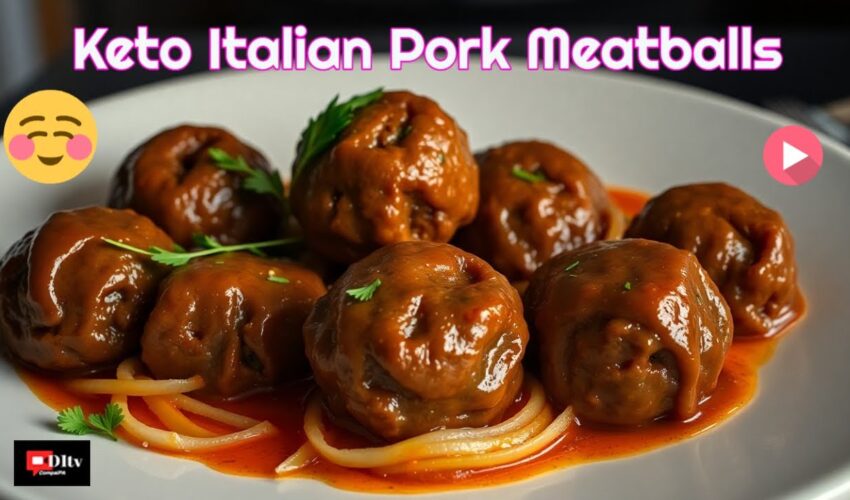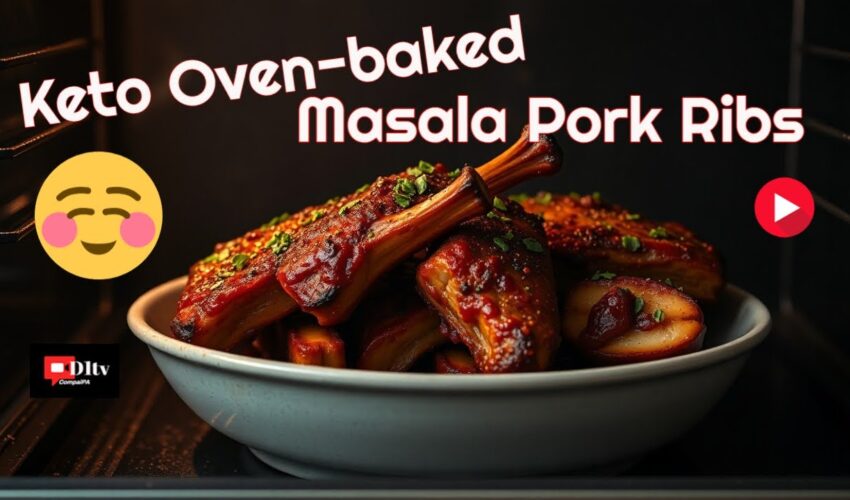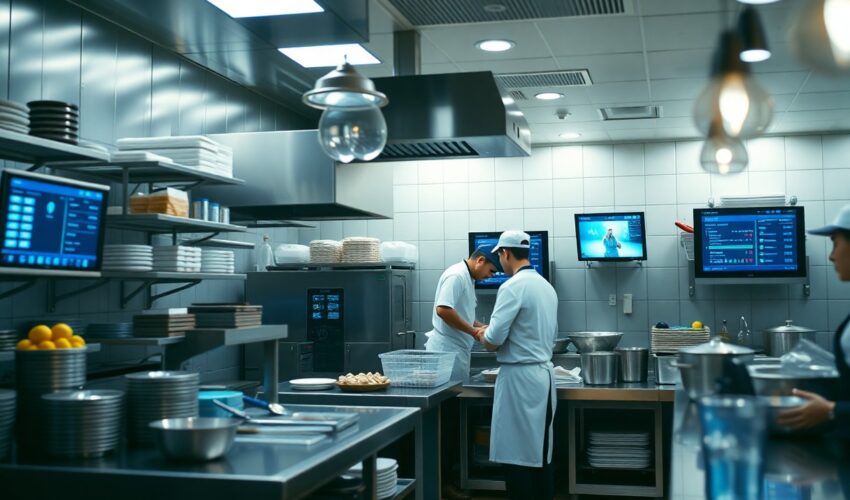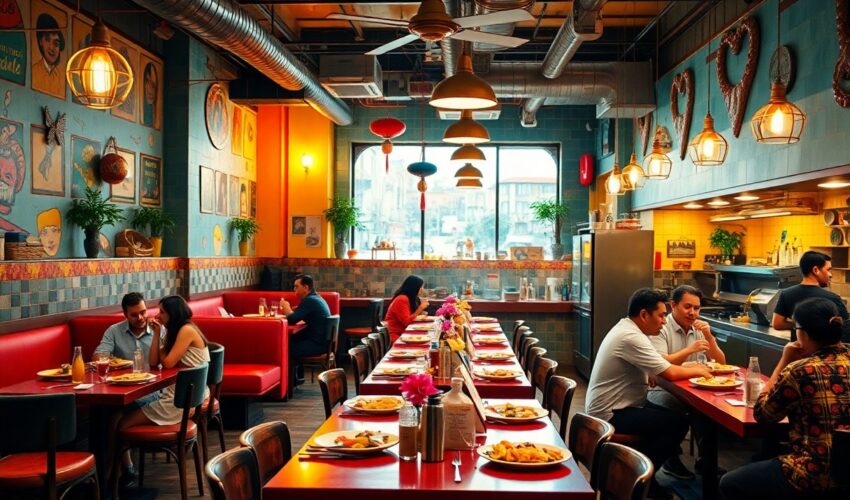The Ultimate Restaurant Business Plan Template That Works
It’s important to have a solid foundation for your restaurant venture, and our Ultimate Restaurant Business Plan Template – 13 episode video playlist provides just that. By following this comprehensive guide, you will effectively outline your concept, address your financials, and develop a strong marketing strategy. This approach will not only help you attract potential investors but also set you on the path to ensuring long-term success in the competitive food industry. Dive in to learn how to create a plan that works for you!

You can watch the 13-video series
Key Takeaways:
- Clearly define your restaurant concept, including theme, cuisine, and target market, to create a strong foundation for your business plan.
- Develop detailed financial projections that include startup costs, operating expenses, and revenue forecasts to present a realistic view of your business viability.
- Outline a comprehensive marketing strategy that includes branding, online presence, and promotional tactics to attract and retain customers.
- Identify your unique selling proposition (USP) to differentiate your restaurant from competitors and appeal to potential investors.
- Create a clear operational plan that addresses staffing, supply chain management, and customer service to ensure smooth day-to-day operations.
- Prepare an executive summary that concisely captures your vision, mission, and business objectives to engage investors quickly.
- Regularly review and update your business plan to adapt to changing market trends and customer preferences, ensuring long-term sustainability.

Understanding Your Restaurant Business Plan Concept
A comprehensive understanding of your restaurant business plan concept is vital for laying the groundwork for your business. This involves several important steps, including defining the type of restaurant you want to open, crafting a unique value proposition, identifying your target market, and analyzing your competitors. Each of these elements will play a significant role in attracting investors and ensuring the long-term success of your restaurant.
Defining Your Restaurant Type
Restaurant types can range widely, from fast-casual dining to upscale gourmet experiences. You need to carefully assess the dining experience you wish to offer based on factors such as cuisine, service style, and overall atmosphere. By clearly defining the category you want to pursue, you can refine your concept and provide clarity to both potential investors and customers.
Additionally, your choice of restaurant type should align with your personal passion and expertise. Are you drawn to vibrant food trucks or cozy bistros? Each type has its unique challenges and opportunities, so take the time to consider what fits best with your vision and values.
Crafting a Unique Value Proposition
Besides defining what your restaurant will be, you must also consider what sets it apart from competitors. A unique value proposition (UVP) is a statement that communicates the distinctive benefits of your restaurant to your target audience. It will help you attract customers who are looking for something special that they can’t find elsewhere. Your UVP should encapsulate not just your menu offerings but also the overall experience you aim to provide.
Restaurant businesses that succeed in communicating their UVP tend to generate stronger customer loyalty and higher word-of-mouth referrals. Consider what makes your restaurant unique—whether it’s locally sourced ingredients, a signature dish, or a unique ambiance—and highlight these elements in your messaging.
Identifying Your Target Market
Above all, understanding your target market is fundamental to your restaurant’s success. Knowing who your customers are allows you to tailor your menu, marketing efforts, and customer service to meet their preferences and needs. Consider factors such as age, income level, lifestyle, and dining habits while defining your ideal customer profile.
Additionally, conducting market research can uncover trends and opportunities that align with your concept. You should continuously refine your understanding of your target market as consumer preferences change over time.
Analyzing Competitors
Your success will largely depend on how well you understand your competition. Analyzing competitors involves examining their strengths and weaknesses, menu offerings, pricing strategies, and market positioning. You should take note of the most successful aspects of other establishments and find ways to differentiate your restaurant by providing a better customer experience or unique offerings.
By doing a thorough competitive analysis, you can identify gaps in the market and focus on how your restaurant can fill those niches, leading to more targeted marketing and growth strategies.
Your analysis should also include regularly checking on how your competitors evolve, as staying informed will allow you to adjust your strategies in response to their moves. This awareness positions you to seize opportunities and counteract potential threats that may arise.
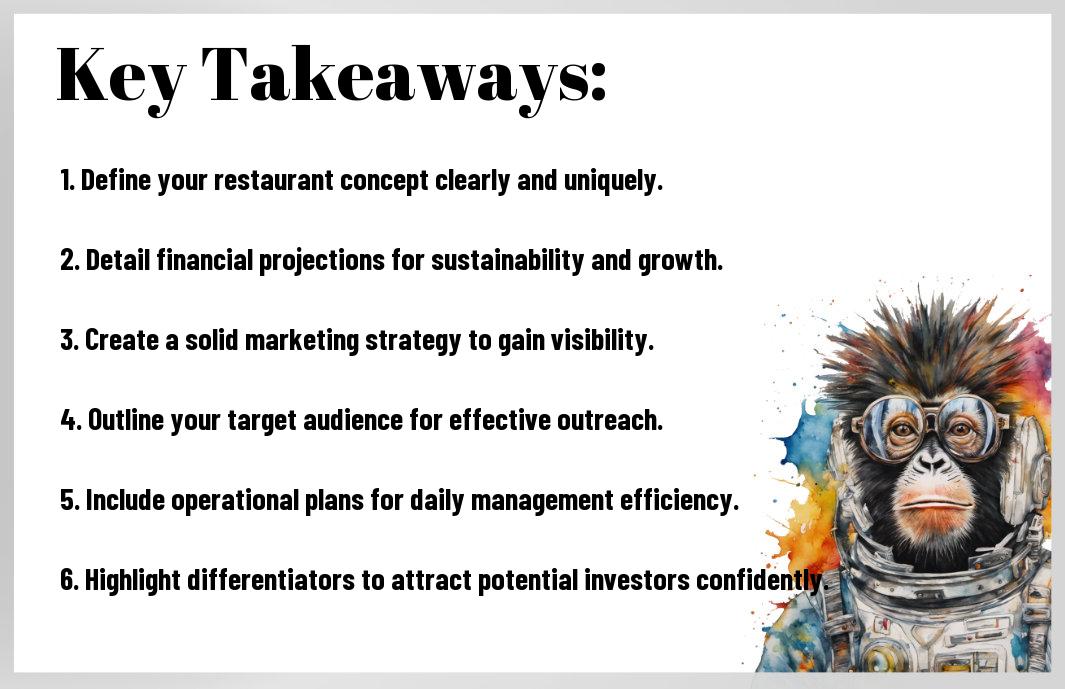

Developing a Comprehensive Restaurant Business Plan
Your journey in the restaurant industry begins with a comprehensive restaurant business plan that serves as your roadmap to success. It allows you to clarify your vision, set clear objectives, and identify the resources you will need to bring your concept to life. Importantly, a well-structured restaurant business plan is necessary for attracting investors, securing financing, and ensuring that you stay on track as you develop your restaurant.
Importance of a Restaurant Business Plan
Between the myriad of operational details and the complexities of the restaurant industry, a solid restaurant business plan becomes your beacon. It not only outlines your vision and goals but also provides a systematic way to approach your business. Investors are eager to see a thoughtful plan that details your concept, target market, and potential for growth, giving them confidence in your venture.
Understanding the market landscape and defining your unique selling proposition through a comprehensive restaurant business plan is critical. It helps you identify potential challenges and equips you with strategies to overcome them. Having this structured document in place leads to informed decision-making and enhances your ability to adapt to changes in the industry.
Key Components of a Restaurant Business Plan
With a focused approach, your restaurant business plan must include several key components to be effective. These elements typically involve an executive summary, market analysis, organizational structure, menu offerings, marketing strategy, and financial projections. Each component plays a vital role in painting a complete picture of your vision.
Due to the importance of integrating these components seamlessly, your restaurant business plan should not only present your ideas but also include concrete data and research. Conducting a thorough market analysis can help you identify your competition and target demographics, allowing you to tailor your offerings to meet the demands of your audience. Additionally, your financial projections should include detailed budgeting, expected revenue, and potential expenses to enable you to manage your resources wisely.
Setting Short-term and Long-term Goals
Business success often hinges on setting both short-term and long-term goals. Short-term goals can include specific marketing tactics, launching promotions, or hiring staff. These help you gain traction quickly and build momentum as you start your restaurant. In contrast, long-term goals might encompass overall growth, expansion plans, or ways to elevate your brand. Establishing a balance between these two perspectives will keep your focus sharp.
Plus, having measurable goals aids in evaluating your progress and adjusting your strategies as necessary. By setting clear benchmarks, you can ensure that you are continually moving toward your long-term vision while actively addressing immediate challenges and opportunities.
Outlining Operational Plans
Against the backdrop of your restaurant business plan, the operational plans are necessary for laying out the day-to-day functions that keep your restaurant running smoothly. This includes staffing plans, inventory management, and customer service protocols. Your operational strategy should aim to maximize efficiency and quality while ensuring that you deliver an exceptional dining experience.
For instance, detailing your approach to staff training and development is vital for establishing a strong team that embodies your brand’s values. Addressing operational challenges such as managing suppliers and maintaining consistency in food preparation can prepare you for common pitfalls and set the foundation for a successful restaurant.
Financial Projections and Management
After outlining your restaurant concept, it’s important to dive deep into the financial projections and management aspect, which will play a pivotal role in attracting potential investors and ensuring the sustainability of your business. A solid financial plan not only provides insight into the long-term viability of your restaurant but also helps you make informed decisions as you move forward. You’ll need to focus on estimating startup costs, forecasting revenue, creating a profit and loss statement, and understanding cash flow management.
Estimating Startup Costs
About estimating your startup costs, you should start by identifying every necessary expense to get your restaurant off the ground. This includes costs related to leasing or purchasing property, renovations, equipment procurement, inventory, initial staffing, and any applicable licenses and permits. By providing a detailed breakdown of your expenses, you not only gain a clearer picture of the financial requirements but also demonstrate to investors that you’ve conducted thorough research and are serious about your venture.
Additionally, when you’re calculating these costs, factor in a buffer for unexpected expenses, which can arise during the initial setup phase. This buffer can be a percentage of your total estimated costs or a fixed dollar amount. Proper planning in this regard allows you to retain flexibility and assures potential investors that you are prepared for challenges.
Revenue Forecasting
After you’ve estimated your startup costs, the next step is to project your potential revenue. Revenue forecasting involves estimating how much money your restaurant will earn based on various factors, including your menu pricing, anticipated customer volume, and seasonal trends. Start by analyzing similar restaurants in your area to determine a realistic expectation for foot traffic and average spending per customer.
Estimating your revenue accurately is vital, as it directly impacts your overall financial health and ability to secure funding. You should also consider various revenue streams, such as takeout, catering, and events, which can help diversify your income and reduce risk.
Estimating your revenue should be an ongoing process that adapts to changing market conditions and consumer preferences. Regularly updating your forecasts based on actual sales data can help you stay on track and make necessary adjustments to your strategies.
Creating a Profit and Loss Statement
An effective profit and loss statement (P&L) is an important financial tool that provides a comprehensive overview of your restaurant’s financial performance over a specified period. The P&L statement summarizes your revenues, costs, and expenses to show how much profit your restaurant generates. This document is crucial for potential investors who will want to see projected profits alongside your revenue forecasts and cost structures.
For instance, when creating your P&L statement, break down your revenue by category (e.g., food sales, beverage sales) and your expenses into fixed and variable costs. This clarity helps you understand the relationship between your income and expenses, enabling you to strategize effectively for better profitability.
Understanding Cash Flow Management
Loss of cash flow can significantly affect your restaurant’s ability to operate effectively. It’s important to monitor your cash inflows and outflows regularly to ensure that you have enough money to cover operational expenses, such as rent, wages, and suppliers. A well-managed cash flow allows you to make informed decisions regarding inventory purchases, staffing, and even future expansions.
Understanding your cash flow involves keeping track of your incoming revenue against outgoing expenses. By implementing effective cash flow forecasting, you can predict potential shortages or surpluses that may affect your daily operations.
Understanding cash flow management is vital for the long-term success of your restaurant. It provides insight into your operational efficiency and your ability to respond to unforeseen circumstances while ensuring your ongoing viability in the competitive restaurant landscape.
Marketing Strategy for Your Restaurant
For aspiring restaurateurs, developing a solid marketing strategy is necessary to establish your restaurant’s identity and drive traffic. A well-defined marketing plan will help you outline ways to attract your target audience, whether through promotions, events, or community engagement.
Building a Marketing Plan
On your journey to crafting an effective marketing plan, start by identifying your restaurant’s unique selling proposition (USP) and target demographics. Your USP should clearly articulate what sets your restaurant apart from competitors; this may include your menu, ambiance, or customer service. Once you’ve defined your target audience, tailor your marketing efforts to resonate with them, ensuring your messaging aligns with their preferences and lifestyle.
Additionally, set measurable goals to evaluate the success of your marketing initiatives. These goals could involve increasing brand awareness, growing your social media following, or boosting reservations during specific days or hours. By defining these targets, you can effectively track your progress and make necessary adjustments to your marketing strategy.
Leveraging Social Media and Online Presence
In today’s digital landscape, having a strong online presence is vital for attracting diners. Utilizing platforms like Instagram, Facebook, and TikTok can showcase your dishes visually and create a buzz around your restaurant. Create engaging content, including images, videos, and stories that reflect your brand’s personality and appeal to your target audience.
This strategy not only allows you to connect with potential customers but also encourages them to share their experiences, expanding your reach through *word-of-mouth* marketing. Consistently engaging with your followers, responding to comments, and posting user-generated content can cultivate a sense of community around your restaurant, making it more inviting for new customers.
Designing a Loyalty Program
One effective strategy to encourage repeat business is to design a loyalty program that rewards customers for their patronage. Loyalty programs can take various forms, from punch cards to digital applications, and should offer enticing rewards that align with your customers’ preferences. Consider offering discounts, free meals, or exclusive access to special events based on patronage frequency or spending levels.
To create a successful loyalty program, ensure that it is easy to understand and simple for customers to enroll. Promote your program through in-house signage and digital channels to maximize visibility, and track its effectiveness by analyzing repeat visitation rates to assess its impact on your overall sales.
Conducting Market Research
At the heart of any effective marketing strategy is thorough market research. Understanding your local market, competitors, and customer preferences will equip you with the insights needed to refine your offerings and marketing initiatives. Utilize surveys, focus groups, and online tools to gather valuable data about what potential customers seek in a dining experience.
And staying updated on industry trends and consumer behavior can guide your marketing efforts, ensuring they remain relevant and powerful. This information will help you make informed decisions about menu offerings, pricing, promotions, and other necessary factors that contribute to your restaurant’s success.
🔥 Why Your Restaurant Business Plan Needs a Winning Brand Strategy 🔥
Create a Restaurant Brand That Leaves a Lasting Impression
If you’re a prospective restaurant owner, your restaurant business plan isn’t complete without a branding blueprint. In a crowded food industry, standing out isn’t optional—it’s essential. Including a dedicated section in your Restaurant Business Plan Template on “How to Create a Winning Restaurant Brand That Stands Out” could be the difference between blending in and becoming a go-to favorite.
🧠 Here’s What to Include and Why It Matters:
1. Name That Sizzles
Your restaurant’s name should reflect your identity, cuisine, and vibe. It’s the first thing people remember—and the foundation of your brand recall.
“Would you eat at ‘Taco Love’ or ‘Generic Eatery #2’?”
2. Logo That Pops
Your logo is your visual handshake. It should be professional, scalable (for signs to social media), and reflect your brand’s personality.
✅ Tip: Think color psychology—red can trigger appetite, while green signals health and freshness.
3. Vibe & Theme
Whether it’s cozy rustic or ultra-modern chic, your restaurant’s atmosphere must align with your target audience. Your theme guides everything from decor to your Instagram feed.
📸 Make it “Instagrammable” and people will do your marketing for you.
4. Your Brand Story
People connect with stories—not just menus. Share why you started the restaurant, your culinary inspirations, or the cultural roots behind your dishes.
💡 A compelling origin story builds loyalty and emotional connection.
5. Customer Experience
Branding isn’t just about visuals—it’s about how people feel dining with you. From service style to video playlist, similar to ours on the big screen, the experience should be intentional and cohesive.
😍 A memorable experience creates repeat customers—and raving fans.
🚀 Your Call to Action
Don’t just open a restaurant—build a brand.
Start with a Restaurant Business Plan Template that includes branding essentials to craft a unique identity from day one.
Funding Your Restaurant Business Plan
All aspiring restaurateurs need a solid plan for funding their new business venture. Securing adequate financing can mean the difference between success and failure for your restaurant. In this section, you’ll explore various methods of funding that will not only help you launch your eatery/restaurant but also sustain it in the long run.
Identifying Funding Sources
Any successful restaurant owner needs to identify multiple sources of funding to ensure financial stability. Start by considering personal savings or funds from friends and family, as these can provide a foundation for your initial capital. Additionally, look into venture capital, which can offer significant investments in exchange for equity in your restaurant.
Alongside these sources, do not overlook traditional options such as bank loans or Small Business Administration (SBA) loans, which can provide you with a reliable influx of cash. Crowdfunding platforms can also be a viable option to engage with your community and raise funds by pre-selling meals or offering special perks to early supporters.
Preparing for Investor Pitches
Among the crucial steps you need to take when seeking funding is perfecting your pitch to potential investors. You should craft a compelling narrative that outlines your restaurant concept, market positioning, and competitive advantages. Highlight why your restaurant stands out in the crowded market, ensuring you capture their interest right from the start.
Funding your restaurant not only involves presenting financial projections but also sharing your vision and passion for the culinary experience you intend to create. Your presentation should visually appeal and reinforce the stability and growth potential of your business to establish trust and confidence with potential investors.
Understanding Grants and Loans
Sources of funding for restaurants can include both grants and loans, which serve unique purposes. Grants typically come from governmental or nonprofit organizations aiming to foster economic growth, especially in underserved communities. Keep in mind that grants often have stringent eligibility criteria, and securing them can be highly competitive.
On the other hand, loans provide you with immediate cash flow but will require repayment with interest. When looking for loans, research local credit unions and banks, as they may offer specific programs for small businesses that cater to the restaurant industry. It’s important to weigh the pros and cons thoroughly to pick the best financing solution for your needs.
Plus, think about researching local and national grant programs that might specifically support culinary arts, new businesses, or innovative food concepts. These grants can be a great resource and help reduce the financial burden of launching your restaurant.
Building Relationships with Investors
Across the board, building meaningful relationships with potential investors can be one of your most valuable strategies for funding your restaurant. Networking within industry circles can help you find investors who share your vision and passion. Attend industry events, participate in food festivals, and engage with local business organizations to create relationships that could lead to beneficial partnerships.
Due to the long-term nature of these relationships, approaching investors with genuine interest in their insights and advice can be beneficial. Building rapport can lead to easier funding options, especially if they already trust your capabilities and have greater confidence in your business plan. Cultivating these connections is important for your restaurant’s ongoing financial health and growth.
Legal and Regulatory Considerations
Despite the excitement of launching your own restaurant, you must navigate the complex landscape of legal and regulatory considerations. Addressing these factors early on will not only help you avoid costly fines and interruptions later on but also demonstrate to potential investors that you are serious about running a compliant and reputable business.
Obtaining Necessary Permits and Licenses
For your restaurant to operate legally, you need to secure a variety of permits and licenses. This often includes a business license, a food service establishment license, and, if you plan to serve alcohol, a liquor license as well. The requirements can differ substantially between states and even local jurisdictions, so you must research the specific regulations in your area. Engaging with local business associations or a lawyer who specializes in hospitality can make this process smoother and ensure that you meet all necessary criteria.
Additionally, failing to obtain the proper permits can result in severe consequences, including being forced to shut down operations temporarily or facing hefty fines. By being proactive in acquiring these licenses, you are laying a solid foundation for your restaurant’s success and signaling to investors that you are committed to compliance.
Understanding Health and Safety Regulations
Necessary for the overall well-being of your patrons and staff, health and safety regulations are a major component of the restaurant business. These regulations dictate everything from food handling and preparation to employee hygiene standards. Familiarizing yourself with local health codes will help you design a restaurant environment that adheres to safety requirements while preventing potential legal troubles.
Legal penalties for non-compliance can be severe, not only impacting your finances but also tarnishing your reputation. It’s vital to establish a culture of safety within your establishment, where employees are trained to follow health procedures diligently. This not only protects your customers but also gives investors confidence in your operational standards.
Navigating Employment Laws
Legal considerations extend to your relationship with your employees as well. You must familiarize yourself with employment laws pertaining to wages, hours, overtime, and workplace safety. Your obligations include adhering to the Fair Labor Standards Act and ensuring a nondiscriminatory hiring process. Understanding these laws also involves being aware of employee rights and implementing appropriate workplace policies.
Failure to comply with employment laws can lead to expensive lawsuits and affect employee morale. Establishing a strong foundation with clear policies protects you and your workers while presenting a professional image to potential investors.
Importance of Insurance in the Restaurant Business Plan
Regulations around insurance can vary greatly, but it is imperative to protect your investment. Obtaining several types of insurance, including general liability, property insurance, and workers’ compensation, is integral to ensuring that you are covered in the event of unforeseen incidents. This network of protections can safeguard your assets and mitigate financial loss.
Insurance not only protects you but also provides peace of mind to potential investors. By showcasing your commitment to risk management, you enhance the credibility and attractiveness of your business plan. In this industry, having adequate coverage isn’t just a safety net; it’s a testament to your professionalism.
Ultimately, addressing these legal and regulatory considerations will set you up for long-term success. By being diligent in understanding and following laws, you position your restaurant as a responsible entity that prioritizes compliance, safety, and operational integrity.
Final Words: Restaurant Business Plan
The Ultimate Restaurant Business Plan Template provides you with the important framework needed to successfully navigate the complexities of launching and sustaining your restaurant. By carefully outlining your concept, financial projections, and marketing strategies, you will not only attract the interest of potential investors but also lay a solid foundation for your restaurant’s long-term success. Each section encourages you to reflect deeply on your unique selling proposition, budget requirements, and customer engagement tactics, ensuring a well-rounded approach to your business model.
As you implement the strategies outlined in the Restaurant Business Plan template, keep your vision clear and your goals achievable. Lay out the necessary steps to bring your dream to life and establish a thriving dining experience that resonates with your target audience. With determination and a well-structured plan, you possess the tools to turn your restaurant dreams into a reality that endures in the competitive culinary landscape.
FAQ
Q: What is the Ultimate Restaurant Business Plan Template?
A: The Ultimate Restaurant Business Plan Template is a comprehensive tool designed to help aspiring restaurant owners outline their business concepts, financial projections, and marketing strategies effectively. It serves as a structured guide to create a solid business plan that can attract investors and set the foundation for long-term success.
Q: How can this template help me define my restaurant business plan?
A: The template provides a structured framework that guides you through the process of articulating your restaurant business plan. It prompts you to consider key elements such as the cuisine type, target market, unique selling proposition, and overall theme of your restaurant, ensuring that you have a well-rounded and compelling concept to present to potential investors.
Q: What financial information should I include in my restaurant business plan?
A: The restaurant business plan template emphasizes the importance of detailed financials, including startup costs, projected revenue, profit margins, and cash flow analysis. It will help you compile projections and assumptions that reflect realistic financial expectations for your restaurant, imperative for gaining investor confidence.
Q: How does marketing strategy fit into this restaurant business plan template?
A: Marketing strategy is a vital component of the restaurant business plan template, as it guides you in defining how you will attract and retain customers. It covers aspects such as branding, online presence, promotional activities, and customer engagement tactics, ensuring that your plan is holistic and addresses your market positioning effectively.
Q: Can this template be customized for different types of restaurants?
A: Yes, the Ultimate Restaurant Business Plan Template is designed to be flexible and adaptable. It provides a baseline structure that you can modify based on your specific restaurant type—whether it’s fine dining, fast casual, or a food truck—allowing you to tailor your plan according to your unique business needs.
Q: Is prior experience in the restaurant industry necessary to use this template?
A: No prior experience is required to use the restaurant business plan template. It is user-friendly and includes step-by-step instructions that are suitable for both newcomers and seasoned professionals. If you’re new to the industry, the template offers insights that can help you understand important concepts and considerations in restaurant planning.
Q: How can this restaurant business plan help with securing investment?
A: By providing a comprehensive and well-researched restaurant business plan, the template equips you with the necessary tools to present a compelling case to investors. A thorough understanding of your concept, financial forecasts, and marketing strategies demonstrates your dedication, significantly boosting your chances of obtaining the funding required to launch and grow your restaurant.
📘 Case Study: How An App Empowers Restaurants to Succeed Online
Client Overview:
Independent restaurant owners across the globe face a common challenge—managing online food orders effectively while retaining control over branding, customer experience, and revenue. This App, an all-in-one restaurant ordering system, is changing the game.
🎯 The Challenge
With third-party delivery apps charging high commissions and limiting direct customer relationships, restaurant owners sought a solution that gave them:
-
A branded online ordering system
-
Direct customer engagement
-
Control over promotions and loyalty programs
-
Seamless integration with websites, apps, and social media
They needed a platform that was easy to set up, powerful in performance, and built to scale with their growth.
💡 The Solution
This App stepped in with a robust suite of tools to help restaurant owners build and manage their own food ordering systems without relying on third-party platforms. Here’s how:
1. Branded Online Ordering System
This App enabled restaurants to launch custom-branded food ordering systems directly on their websites, mobile apps, and social media pages.
“We went live with our own ordering site in a day—customers noticed the difference immediately.” – La Pizzeria Roma
2. Mobile App Integration
This App offered seamless branded mobile app creation, allowing customers to place orders anytime, anywhere, while reinforcing the restaurant’s brand.
3. Social Media Ordering
Integrated ordering buttons on Facebook and Instagram meant customers could order straight from where they spend most of their time online—social media.
📈 The Features that Delivered Results
🔁 Loyalty Programs & Rewards
Restaurants used This App to build custom loyalty programs, encouraging repeat business and boosting average order value.
“Customers now return just to use their rewards—it’s made a real impact.” – Sushi Garden
🎁 Promotions & Campaigns
This App allowed restaurants to launch targeted promotional campaigns—from discount codes and flash sales to special event menus—without the need for marketing know-how.
💬 Customer Engagement Tools
With built-in customer data analytics, feedback forms, and review management tools, restaurant owners could build relationships with their patrons and improve service quality in real-time.
🚀 Results & Impact
After implementing This App, restaurants reported:
-
35% average increase in online orders
-
30% savings on commission fees by ditching third-party apps
-
40% increase in repeat orders via loyalty programs
-
Stronger branding and customer recognition online
“We now OWN our customer journey—from first click to final bite. This App gave us that power.” – TacoFiesta Grill
Get involved.
Authored by Team D1tv CompaiPA

